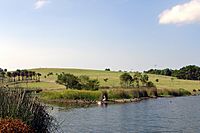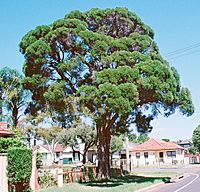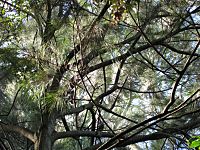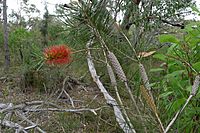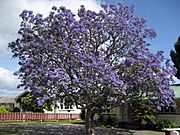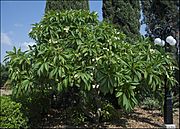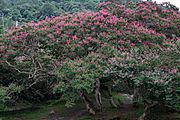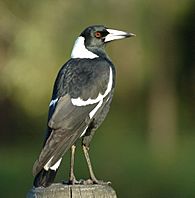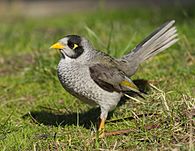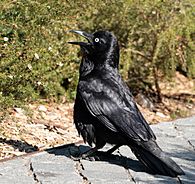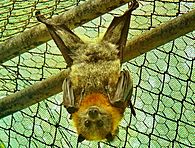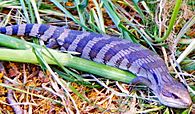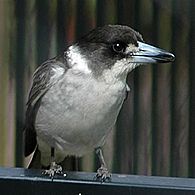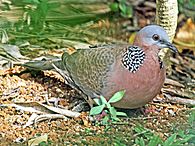Ecology of Sydney facts for kids

The ecology of Sydney, located in the state of New South Wales, Australia, is diverse for its size, where it would mainly feature biomes such as grassy woodlands and some sclerophyll forests, with a few pockets of mallee shrublands, subtropical and temperate rainforests (evergreen), heathlands, and wetlands. The combination of climate, topography, moisture, and soil influence the dispersion of these ecological communities across a height gradient from 0 to 200 metres (0 to 700 ft). There are many hiking trails, paved and unpaved roads for exploring the many different biomes and ecosystems.
Grassy woodlands, the most predominant biome in the Sydney region, mainly occur in the Cumberland Plain west of Sydney CBD, which generally feature eucalyptus trees that are usually in open, dry sclerophyll woodland areas with shrubs (typically wattles, callistemons, grevilleas and banksias) and sparse grass in the understory, reminiscent of Mediterranean forests. The plants in this community tend to have rough and spiky leaves, as they're grown in areas with low soil fertility. Wet sclerophyll forests, which are part of Eastern Australian temperate forests, have narrow, relatively tall, dense trees with a lush, moist understorey of fleecy shrubs and tree ferns. They are mainly found in the wetter areas, such as Forest District and the North Shore.
The Sydney Turpentine-Ironbark Forest, one of six main indigenous forest communities of Sydney, is an example of a dry sclerophyll forest, containing trees around 20–30 metres tall, with ground cover composed of flowering shrubs and native grasses. The Blue Gum High Forest, strictly found in northern parts of Sydney, is a wet sclerophyll forest example, where the annual rainfall is over 1100 mm (43 in), with its trees between 20 and 40 metres tall.
It has been calculated that around 98,000 hectares of native vegetation remains in the Sydney metropolitan area, shaping the geography of Sydney, about half of what is likely to have been existing at the time of European arrival.
Contents
Historical description
In 1819, British settler William Wentworth described Sydney's vegetation and landform in great detail:
For the distance of 5 mi (8.0 km) to 6 mi (9.7 km) from the coast, the land is in general extremely barren, being a poor hungry sand, thickly studded with rocks. A few miserable stunted gums, and a dwarf underwood, are the richest productions of the best part of it; while the rest never gives birth to a tree at all, and is only covered with low flowering shrubs, whose infinite diversity, however, and extraordinary beauty, render this wild heath the most interesting part of the country for the botanist, and make even the less scientific beholder forget the nakedness and sterility of the scene.
Beyond this barren waste, which thus forms a girdle to the coast, the country suddenly begins to improve. The soil changes to a thin layer of vegetable mould, resting on a stratum of yellow clay, which is again supported by a deep bed of schistus. The trees of the forest are here of the most stately dimensions. Full sized gums and iron barks, along side of which the loftiest trees in this country would appear as pigmies, with the beefwood tree, or as it is generally termed, the forest oak, which is of much humbler growth, are the usual timber. The forest is extremely thick, but there is little or no underwood.
At this distance, however, the aspect of the country begins rapidly to improve. The forest is less thick, and the trees in general are of another description; the iron barks, yellow gums, and forest oaks disappearing, and the stringy barks, blue gums, and box trees, generally usurping their stead. When you have advanced about 4 mi (6.4 km) further into the interior, you are at length gratified with the appearance of a country truly beautiful. An endless variety of hill and dale, clothed in the most luxuriant herbage, and covered with bleating flocks and lowing herds, at length indicate that you are in regions fit to be inhabited by civilized man. The soil has no longer the stamp of barrenness. A rich loam resting on a substratum of fat red clay, several feet in depth, is found even on the tops of the highest hills, which in general do not yield in fertility to the valleys. The timber, strange as it may appear, is of inferior size, though still of the same nature, i. e. blue gum, box, and stringy bark. There is no underwood, and the number of trees upon an acre do not upon an average exceed thirty. They are, in fact, so thin, that a person may gallop without difficulty in every direction.
Biomes
- Rainforests
- Subtropical rainforests – Found in areas around Royal National Park, Helensburgh and Illawarra escarpment to the south of Sydney, albeit in very small, isolated portions.
- North Coast Warm Temperate Rainforests – Dominated by Ceratopetalum apetalum, Doryphora sassafras and Acmena smithii, it is scarcely present in the RNP and Hacking River valley in around Sutherland in southern Sydney, and predominant in the Ku-ring-gai Chase National Park and Turramurra in Northern Sydney, near Hornsby.
- Dry Rainforests or Western Sydney Dry Rainforest – A component of the Cumberland Plain Woodland, it is distributed across the dry areas to the south of Blue Mountains and in small portions in Calmsley Hill Farm in Western Sydney Parklands, near Abbotsbury, New South Wales. They have Alectryon subcinereus and Clerodendrum tomentosum as shrubby covers.
- Littoral Rainforests – Dominated by Acmena smithii, Ficus rubiginosa, and Elaeodendron australe, it occurs in sporadic areas in northern Illawarra to Royal National Park (near Bundeena and in Towra Point Nature Reserve in Sutherland Shire), and also in one diminutive area in Northern Beaches Council (Mona Vale) in the Northern Suburbs to Newcastle.
- Wet scleropyhll forests
- North Coast Wet Sclerophyll Forests – Dominated by tall Eucalyptus saligna and Eucalyptus pilularis, karrabina, peppermints, Eucalyptus oreades and Eucalyptus globulus, and receiving high amount of rainfall (above 1000 mm), it is present in Ku-ring-gai Council, Hornsby Shire, Narrabeen, Lane Cove, Pennant Hills and Castle Hill in the north, and in the Illawara region, with small portions in Ryde, North Parramatta and Pittwater.
- Northern Hinterland Wet Sclerophyll Forests – Dominated by Eucalyptus resinifera and Syncarpia glomulifera, it was once extensive on the north shore across the local government areas of Hornsby, Ku-ring-gai, Ryde, Willoughby, Lane Cove, Parramatta, Baulkham Hills and Blacktown to the north of Sydney, with small outliers in Menai, Bankstown and Auburn in the southwest.
- Sydney turpentine ironbark forest – Characterized by thick shrubs and dominated by Syncarpia glomulifera, it is a tall open forest with trees as high as 30 metres and is found on shale and shale-meliorated soils found in small pockets at Campbelltown, Heathcote and Menai.
- Southern Lowland Wet Sclerophyll Forests – Containing Corymbia maculata, it is found in upper Narrabeen, Pittwater, Woronora and Illawara, as well as on the foreshores of Hacking, Parramatta and Georges Rivers.
- Grassy Woodlands
- Cumberland Plain Woodland – These are shrub and grass eucalyptus communities located in areas of low to moderate rainfall (less than 950 millimetres annually) and are most commonly found in large parts of the Sydney metropolitan area, namely in Western Sydney or the Cumberland Plain. Moist Shale Woodlands also exist within this biome, but they're distinguished by their lusher plant habitats. It is a dry woodland remnant containing waxy-leaved shrubs, twiners, herbs and small trees in a grassy understorey. It has a number of sub-regions: Moist Shale Woodlands, Western Sydney dry rainforest, Shale gravel transition forest, and Shale gravel transition forest, among others.
- Dry sclerophyll forests
- Sydney Coastal Dry Sclerophyll Forests – Predominant on the northeast parts of the Woronora Plateau on ridgelines within the Royal, Heathcote and Dharawal national parks and Garawarra State Conservation Area in southern Sydney. It is also present in north of Sydney Harbour and extends to both sides of the Hawkesbury River in Northern Beaches and Hornsby LGA's and Pennant Hills.
- Sydney Hinterland Dry Sclerophyll Forests – Found in the drier parts (less than 950 mm) of the Woronora Plateau, also in Appin, Sandy Point, pockets in the southwestern edges of the Cumberland Plain (on the doorsteps of the Blue Mountains), and on the foreshores of the Hawkesbury River, it features 10–25 m tall eucalyptus trees with ostensible sclerophyll shrub understorey and open groundcover of sclerophyll sedges.
- Cooks River/Castlereagh ironbark forest – Found in Castlereagh and Holsworthy, and a few remnants in the cities of Auburn, Bankstown and Liverpool, it is an ironbark shrub-grass forest located in western Sydney that sit on gravelly-clay soils and is made up of a moderately tall open eucalyptus forest or woodland to a low compact brush of paperbarks with nascent eucalypts. Broad-leaved ironbark (Eucalyptus fibrosa) is the most commonly spotted tree.
- Sydney Sand Flats Dry Sclerophyll Forests – Present in northern Holsworthy with smaller examples at Rookwood and Villawood and is dominated by Eucalyptus sclerophylla.
- Coastal Dune Dry Sclerophyll Forests – Examples are found at Bundeena, Kurnell and La Perouse in southern Sydney containing a collection of sclerophyllous shrub and heath species and a ferny ground cover.
- Heathlands
- Wallum Sand Heaths – Present in Pleistocene sand dunes sitting high on sandstone cliff tops between Bundeena in Royal NP, Woollahra, Kurnell peninsula, Narrabeen and Sydney Heads which contain Allocasuarina distyla, Banksia serrata and Banksia aemula. There are also a wide variety of woody species such as tea-trees, grevilleas, peas and wattles. The ground layer comprises on open cover of sedges and forbs.
- Sydney Coastal Heaths – Found extensively in the Sydney metropolitan area and in the eastern parts of the Woronora and Hornsby plateaus particularly in Royal and Ku-ring-gai national parks with prominence of Eucalyptus luehmanniana.
- Coastal Headland Heaths – Found in and around Garie Beach on the outskirts of southern Sydney, near Royal NP.
- Freshwater Wetlands
- Castlereagh swamp woodland – A swampy sclerophyll forest affiliated with sporadically flooded soils containing Tertiary, Holocene and Quaternary sand deposits. It is found in low-elevated areas of Liverpool and in Voyager Point, and is made up of moderate to heavy cover of paperbark trees.
- Coastal Heath Swamps – Common in Holsworthy defense area, Woronora catchment area and the Hornsby plateau including Garigal and Ku-ring-gai Chase national parks.
- Coastal Freshwater Lagoons – Occurs on poorly drained alluvial flats and sand depressions and may be surrounded by broad-leaved cumbungi (Typha orientalis).
- Forested wetlands
- Sydney coastal river-flat forest – Found on the river flats of the coastal floodplains in most parts of the plain that has rivers or creeks. It has an open tree layer of eucalypts which may surpass 40 m in height.
- Coastal Swamp Forests – Occupies the low-lying coastal river flats, swamps and sand depressions, which are mostly cleared from the Sydney metropolitan area, but still exist in places like Georges River National Park, Milperra, Chipping Norton, Prospect Creek and Kurnell in southeastern Sydney, and Wheeler Heights, Narrabeen and Dee Why in the Northern Beaches.
- Coastal Floodplain Wetlands – They cover a series of eucalypt and casuarina dominated communities found on low-lying coastal alluvial soils, such as in Georges River and its tributaries in northern Woronora and the lowlands of Blue Mountains. They are dominated by Microlaena stipoides.
- Eastern Riverine Forests – Many riparian scrubs are found on rocky creeks that are enclosed with coarse sandy alluvial deposits with common vegetation being Tristaniopsis laurina.
- Saline Wetlands
- Mangrove Swamps – Common in Towra, they're a basic community dominated by either Avicennia marina or Aegiceras corniculatum.
- Saltmarshes – Usually located on estuarine alluvial soils, small tracts also exist on headlands exposed to prevailing sea spray.
- Seagrass Meadows – Occurring on sandy nether of coastal estuaries and bays, they include a number of subaqueous aquatic species, such as eel grass (Zostera spp) and sea grass (Posidonia australis).
Complete list
| Biomes | Eco-communities |
|---|---|
| Rainforests | |
| Wet Sclerophyll Forests | |
| Grassy Woodlands | |
| Coastal Grasslands | |
| Dry Sclerophyll Forests | |
| Heathlands | |
| Freshwater Wetlands | |
| Forested Wetlands | |
| Saline Wetlands |
Vegetation
The most widespread eucalyptus species in the Sydney region include:
- Angophora costata (Sydney red gum)
- Eucalyptus amplifolia (cabbage gum)
- Eucalyptus piperita (Sydney peppermint)
- Eucalyptus sieberi (silvertop ash)
- Eucalyptus oblonga (stringybark)
- Eucalyptus capitellata (brown stringybark)
- Eucalyptus bosistoana (coast grey box)
- Eucalyptus moluccana (grey box)
- Corymbia gummifera (red bloodwood)
- Eucalyptus racemosa (snappy gum)
- Eucalyptus haemastoma (scribbly gum)
- Corymbia maculata (spotted gum)
- Eucalyptus luehmanniana (yellow top mallee ash)
- Eucalyptus eugenioides (thin-leaved stringybark)
- Eucalyptus robusta (swamp mahogany)
- Eucalyptus baueriana (round leaf box)
- Eucalyptus longifolia (woollybutt)
- Eucalyptus paniculata (grey ironbark)
- Eucalyptus punctata (grey gum)
- Eucalyptus melliodora (yellow box)
Non-eucalyptus tree species:
- Araucaria cunninghamii (hoop pine)
- Araucaria bidwillii (bunya pine)
- Corymbia eximia (yellow bloodwood)
- Allocasuarina torulosa (forest oak)
- Melaleuca linariifolia (snow-in-summer)
- Melaleuca quinquenervia (broad-leaved paperbark)
- Melaleuca alternifolia (narrow-leaved paperbark)
- Melaleuca armillaris (bracelet honey myrtle)
- Melaleuca decora (white feather honeymyrtle)
- Tristaniopsis laurina (water gum)
- Acacia falcata (sickle wattle)
- Callitris endlicheri (black cypress pine)
- Grevillea robusta (Australian silver oak)
- Acacia longifolia (Sydney golden wattle)
- Acacia podalyriifolia (Mount Morgan wattle)
- Melaleuca quinquenervia (paperbark tea tree)
- Syncarpia glomulifera (turpentine tree)
- Syzygium smithii (black cypress pine)
- Banksia integrifolia (coast banksia)
- Brachychiton acerifolius (Illawarra flame tree)
- Brachychiton populneus (kurrajong)
- Melaleuca viminalis (weeping bottlebrush)
- Cupaniopsis anacardioides (tuckeroo)
- Ficus macrophylla (Moreton Bay fig)
- Ficus microcarpa (Hill's weeping fig)
- Ficus rubiginosa (Port Jackson's fig)
- Flindersia australis (crow's ash)
- Glochidion ferdinandi (cheese tree)
- Lophostemon confertus (brush box)
Common shrub species include, but are not limited to:
- Banksia serrata (old man banksia)
- Casuarina glauca (swamp oak)
- Ceratopetalum gummiferum (New South Wales Christmas bush)
- Lomandra longifolia (spiny-head mat-rush)
- Banksia spinulosa
- Xanthosia pilosa (woolly xanthosia)
- Banksia aemula (wallum banksia)
- Banksia robur (swamp banksia)
- Melaleuca citrina (lemon bottlebrush)
- Melaleuca linearis (narrow-leaved bottlebrush)
- Dichondra repens (kidney weed)
- Centella asiatica (Asiatic pennywort)
- Veronica plebeia (trailing speedwell)
- Ozothamnus diosmifolius (rice flower)
Introduced
Introduced trees:
- Jacaranda mimosifolia (blue jacaranda)
- Cinnamomum camphora (camphor laurel)
- Pinus radiata (Monterey pine)
- Plumeria rubra (red frangipani)
- Liquidambar styraciflua (sweet gum)
- Platanus × acerifolia (London planetree)
- Vachellia farnesiana (mimosa bush)
- Ailanthus altissima (tree of heaven)
- Olea africana (African olive)
- Gleditsia triacanthos (honey locust)
- Eriobotrya japonica (Japanese medlar)
- Araucaria heterophylla (Norfolk Island pine)
- Lagerstroemia indica (crepe myrtle)
Introduced shrubs (most of are invasive species):
- Thunbergia grandiflora (blue skyflower)
- Alternanthera philoxeroides (alligator weed)
- Anredera cordifolia (Madeira-vine)
- Asparagus aethiopicus (asparagus fern)
- Lantana camara (West Indian lantana)
- Cestrum nocturnum (night-blooming jasmine)
- Senna septemtrionalis (arsenic bush)
- Ochna serrulata (Mickey Mouse plant)
- Ligustrum sinense (small-leaved privet)
- Solanum mauritianum (wild tobacco bush)
- Talinum paniculatum (jewels-of-opar)
- Ricinus communis (castor oil plant)
- Introduced tree species
-
Jacarandas are widely grown as ornamental trees.
-
The London plane is used extensively as a street tree in Sydney suburbs.
-
Monterey pines were introduced to Sydney in the 1870s and are now "the dominant tree species in the Australian plantation estate".
-
Frangipani is widely seen in cultivation in Sydney and warmer frost free climates northwards.
-
Camphor laurel was introduced to Australia in 1822 as an ornamental tree for use in gardens and public parks.
-
Native to eastern Asia, crepe myrtles are common ornamental trees in suburban streets.
Wildlife
The fauna of the Sydney area is diverse and its urban area is home to variety of bird and insect species, and also a few bat, arachnid and amphibian species. Introduced birds such as the house sparrow, common myna and feral pigeon are ubiquitous in the CBD areas of Sydney. Moreover, possums, bandicoots, rabbits, feral cats, lizards, snakes and frogs may also be present in the urban environment, albeit seldom in city centers.
About 40 species of reptiles are found in the Sydney region and 30 bird species exist in the urban areas. Sydney's outer suburbs, namely those adjacent to large parks, have a great diversity of wildlife. Since European settlement and the subsequent bushland clearing for the increasing population, 60% of the original mammals are now considered endangered or vulnerable, and many reptile species are experiencing population diminution and are becoming elusive.
Tetrapods
This list includes bird species that are widespread in the Sydney metropolitan area:
- Australian magpie
- Australian raven
- Australian white ibis
- Bell miner
- Common starling
- Crested pigeon
- Eastern rosella
- Eastern spinebill
- Galah
- Grey butcherbird
- Laughing kookaburra
- Magpie lark
- Masked lapwing
- Noisy miner
- Pacific koel
- Pied currawong
- Rainbow lorikeet
- Spotted dove
- Silver gull
- Sulphur-crested cockatoo
- Superb fairy-wren
- Willie wagtail
Although not commonly spotted, these birds are also present in Sydney:
- Australian king-parrot
- Brown goshawk
- Common bronzewing
- Eastern yellow robin
- Golden whistler
- Little wattlebird
- Little raven
- Nankeen kestrel
- New Holland honeyeater
- Pallid cuckoo
- Peregrine falcon
- Red-browed finch
- Red wattlebird
- Red-whiskered bulbul
- Silvereye
- Tawny frogmouth
- Turquoise parrot
- Whistling kite
- White-bellied sea-eagle
This list includes mammal, reptile and amphibian species that are spotted in the Sydney urban area:
- Australian blue-tongued skink
- Australian green tree frog
- Australian water dragon
- Bibron's toadlet
- Bleating tree frog
- Broad-headed snake
- Bush rat
- Common bent-wing bat
- Common brushtail possum
- Common ringtail possum
- Common garden skink
- Common death adder
- Diamond python
- Eastern brown snake
- East-coast free-tailed bat
- Great barred frog
- Giant burrowing frog
- Golden bell frog
- Golden water skink
- Grey-headed flying fox
- Leaf green tree frog
- Long-nosed bandicoot
- Squirrel glider
- Sugar glider
- Three-toed earless skink
- Yellow-bellied glider
- Peron's tree frog
- Red-bellied black snake
- Snake-eyed skink
- Three-toed earless skink
Arthropods
This list includes insect, spider and centipede species that are commonly present in Sydney:
- Australian carpet beetle
- Australian garden orb weaver spider
- Australian grapevine moth
- Australian painted lady
- Bess beetle
- Black house spider
- Brush-tailed phascogale
- Emperor gum moth
- Feathertail glider
- Giant centipede
- Green-head ant
- Imperial hairstreak
- Christmas beetle
- Funnel ant
- Green vegetable bug
- House centipede
- Katydid
- Orchard swallowtail butterfly
- Bronze flat
- Green vegetable bug
- Redback spiders
- Pill bug
- Plague soldier beetle
- Punctate flower chafer
- Redback spider
- Skull spider
- Sydney funnel-web spider
- Sydney huntsman spider
- Spider wasp
- Transverse ladybird
- Zizina labradus
- Tiger spider Trichonephila plumipes
Images for kids
-
Royal Botanic Garden, lying in the highest hardiness zone at 11a, with palm trees and subtropical vegetation.
-
The Hawkesbury valley, covered in frost, has the lowest hardiness zone in Sydney at 9b.





